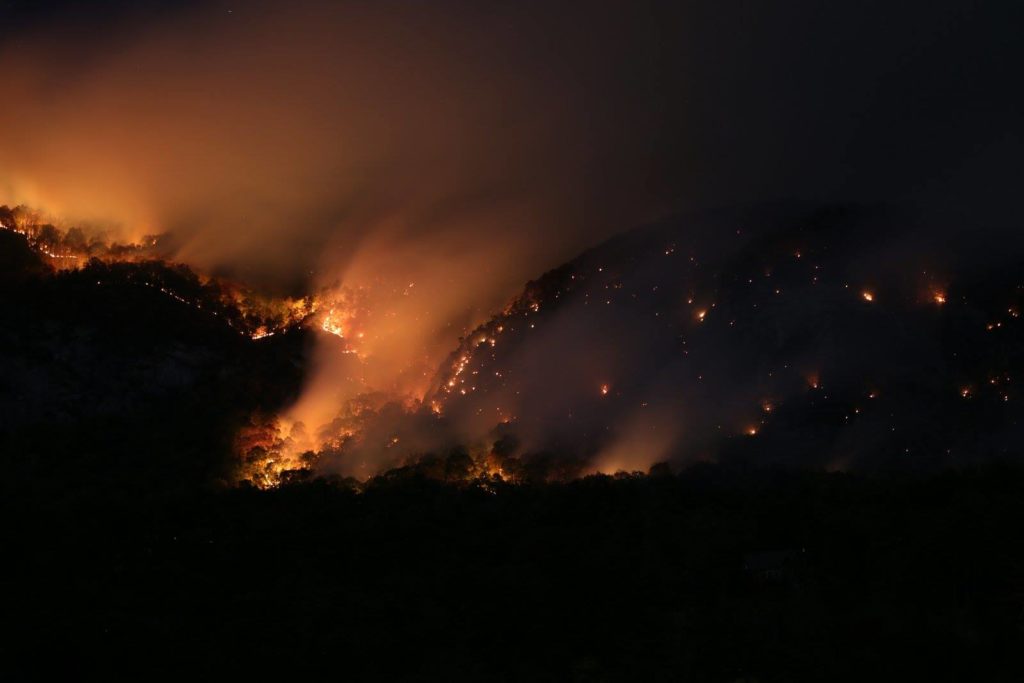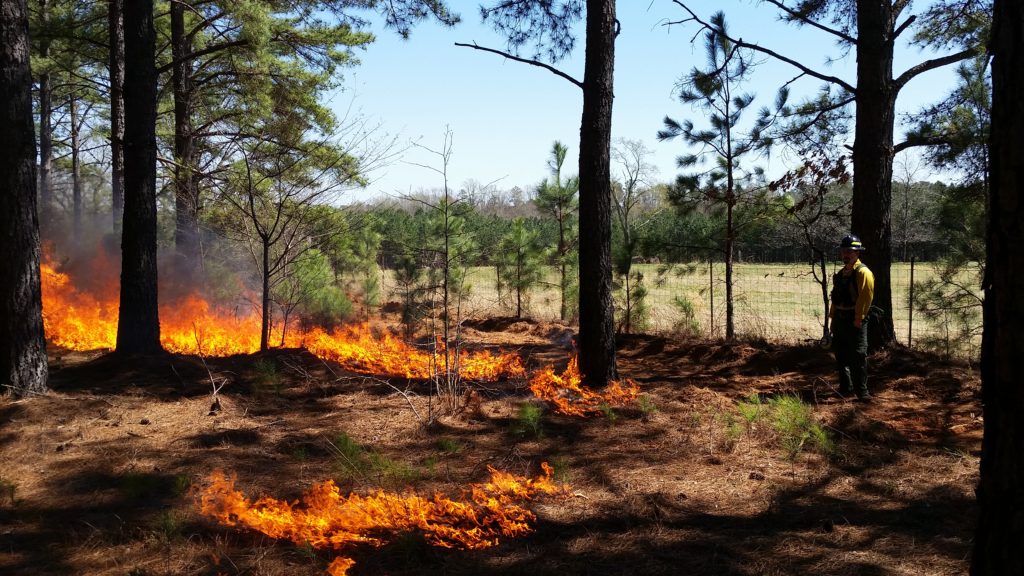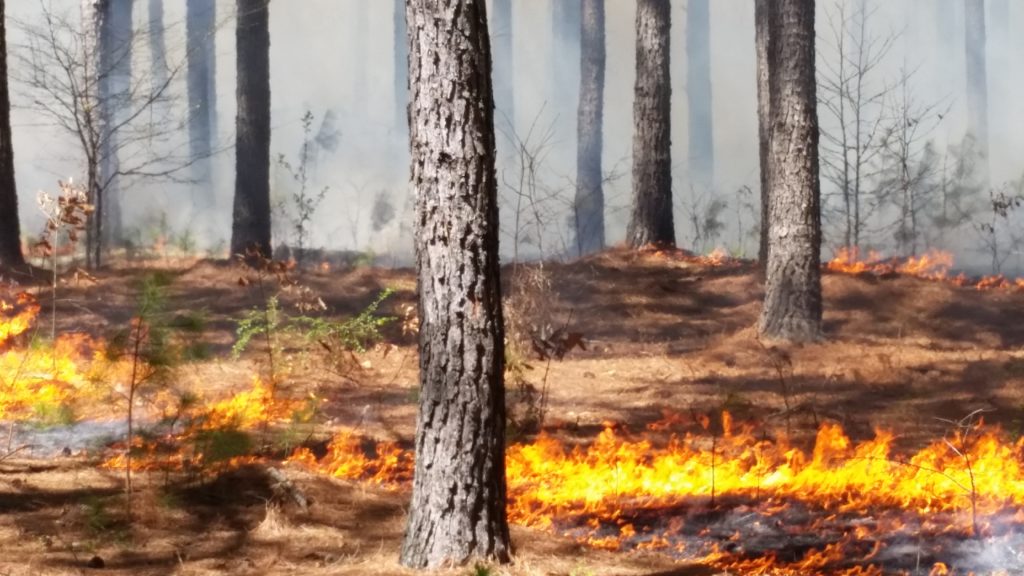Fire in WNC: Risks and Benefits

For thousands of years, much of North Carolina burned every 1 to 10 years either at the hands of humans or lightning. More than 10,000 years ago, humans began burning southern forests to drive game, clear land for nutrient-rich farming, and even enhance grazing conditions for wildlife. Today, we are still closely intertwined with our relationship to fire.
On Feb. 15, Brian Rogers and Justin Query of the North Carolina Forest Service presented on “You, Me, and the WUI–A Look at the Wildland Urban Interface” as part of our free monthly speaker series at Walnut Creek Preserve in Polk County.
In addition, Rachel Hess, our AmeriCorps Communications and Education Associate interviewed ranger Brian Rogers. In this interview, Rogers tells us how best to protect our properties from wildfires in WNC. He also discusses the benefits of prescribed burning and why it can be a healthy choice for landowners looking to enhance habitat for wildlife.
What is your role as a NC Forest Service Ranger for Polk County?
As a District Ranger I oversee our District Forest Program consisting of tree planting, timber harvest inspections, fire prevention, fire training, invasive species control, and forest management. I am dispatched to every fire in our surrounding counties to provide resources and support.
What is the wildland-urban interface and are communities in Western North Carolina at-risk?
The wildland-urban interface is where our forest land meets developed land. Western North Carolina has one of the largest acreages of wildland-urban interface in the country. Many houses are built within or bordering nearby forests. This can complicate things when fighting a fire and increase the potential for evacuation. The majority of our fires are human-caused. People that burn debris in their yard, it escapes their control, and escapes into our wildlands. Human-caused fires are our number one cause of ignition.
You might think with all of this rain and flooding lately that wildfire wouldn’t be a problem for us in Western North Carolina, but it is. Does any specific fire event come to mind as a prime example of how wildfires can affect a community?
Rogers shares his account of the Party Rock Fire in Lake Lure.
In 2016, we had quite a few fires. Drought conditions from the summer into the fall fueled many of the fires during this time.We had to bring in resources from across the state and the country to assist us during that fire season. We had firefighters specialized in both wildland and structural fire to support providing structural protection for homes in that community. It took 2-3 weeks to put that fire out.
Video: Cathy Anderson Photography
You also work with prescribed burning. Could you tell me about the benefits of fire for wildlife habitat?
We conduct prescribed burning across the district for a variety of reasons. To reduce risk for wildfires, promote wildlife habitat, cultural reasons, promote the health of the forest, or prepare a site for planting trees. Prescribed burning increases wildlife habitat, opening up the understory and putting nutrients back into the soil, freeing up competition, and increases timber growth.
Does fire kill wildlife or have they learned to adapt?
An area that we prescribe burn reduces the litter layer on the ground and makes the area exposed for seeds and insects. These burned areas are desirable to species like turkey or quail where they can feed. The Red-cockaded woodpecker, which is endangered, prefers only fire-adapted pines for their nest cavities.
We’ve even done prescribed burns in the morning and by the afternoon, turkeys will already be in that area taking advantage of that freshly exposed food source. They really seem to thrive on this. In a location we’ll burn regularly, every time I’d see a red-tailed hawk show up, sit and wait, and as the mice would come running out of the burn block, it was there to take advantage of the easy prey.

You mentioned how much burns can help habitat. Are there any particular fire-assisted plants that rely on these prescribed burns or natural fires?
Table Mountain Pine has a closed, serotinous cone. It needs that heat or extended dry to open that cone and allow the seeds to fall out. Most of our yellow pine species are shade intolerant and need full sunlight to regenerate. Not only does fire open the cone but it also clears out an area for that seed to germinate and start again. We typically find those where fire would have the most intensity. It relies on that fire for regeneration. Table Mountain Pine is not rare but it’s less common. It thrives on the high and dry ridges where other species can’t compete.
Are there threats to vegetation from wildfire?
Anytime there’s development in an area, it changes that species’ composition. In a disturbed area, it seems to bring in more invasive species that might not have been there previously. When you clear a site, it opens it up. There’s disturbances in the soil, but there’s also the seeds and other plants that are brought in during development. Some of these plants that are coming in are competing with native vegetation. They are also more flammable than native species. Especially in western counties, we’re seeing a lot of Chinese Silvergrass in these disturbed areas. It’s a non-native species and extremely flammable, burning at a higher intensity than our native grass species.
Silvergrass is burning at a higher intensity. The native trees and plants that would typically inhabit those fields are unable to tolerate those really high fire temperatures, killing them back, and promoting this invasive grass to continue spreading throughout the landscape and increasing the fire risk even more.
Historically, fire would keep down species like Red Maple and limit the amount of Mountain Laurel and Rhododendron found in our understory. We still have those species, but now with their own adaptions to fire, it’s spreading and covering whole hillsides. Instead of having Mountain Laurel on slopes, we should have grasses and wildflowers in their place. The absence of fire is choking out everything in the understory. When these plants take over a slope, it really prevents oak seedlings from developing because they’re getting shaded out. We have older oaks in the overstory, but we don’t have their seedlings growing to take their place once they die out.

How do you determine if a prescribed burn is right for your property? Do you need a certain acreage?
It depends on the landowner’s objectives and what they want from the property. It also depends on the tree species and age of the trees there. Some trees need fire, species like Table Mountain Pine, need that fire to open up their cone to release seeds. Other species with thinner bark can be harmed by fire such as Red Maple. They don’t tolerate fire as well.
We don’t necessarily have a minimum acreage for prescribed burning, but we try to focus on larger tracts to get the most benefit from a burn. We’ve done 5-acre burns to 100-acre burns.
One of our limiting factors is managing the smoke from the prescribed burn so we’re not negatively impacting smoke-sensitive areas. If there’s a lot of development in an area, it’s really difficult to maintain where that smoke goes downwind from the burn.
How can someone best maintain their land to prevent damage from wildfires?
To prevent the spread of embers, do some housekeeping around the house. Remove the leaves against the house, clean the gutters, and prune the bushes. Move yard waste piles at least 30 feet away from the house. Mountain Laurel and Rhododendron are highly flammable plants due to their waxy leaves. Their lower branches act as lighter fuels and should be pruned close to the ground to prevent the spread of flying embers from climbing into the tree canopies.
It’s a good idea to leave your leaves and downed trees for habitat, but is this a concern for fire safety?
Fires are most likely to burn through the leaf litter. The 30-foot perimeter around your house is the most defensible space you have. It’s the most critical area in preventing wildfire on your property. Flying sparks can quickly ignite dry materials or invasive plants. Keep your gutters free of leaves, pine needles, and debris. You can make your property less susceptible by moving leaf piles at least 30-feet away from the home.
Do you think climate change is noticeably affecting your ideal burning schedule over the last few years?
With the weather patterns we’ve had, the last three years have been really hard on us to get burns done. We don’t want to burn when it’s extremely dry but we need it to be dry enough. With the frequent rain we’ve had, it’s harder to find those dry days. In 2016, it was too dry to safely burn. Our resources were committed to fighting fire. We need that balance of dry and wet weather. Right now it’s really wet, and we need 3-4 drying days after a rain event to get these burns done.

Do you have any other suggestions for homeowners to be better prepared in the event of a wildfire?
Reflective numbers on their mailbox to help emergency responders locate the address. Provide the road access for responders and space to turn around in addition to making the area immediately surrounding your home less prone for wildfire risk. There’s also a nationwide program for landowners called FireWise. You can contact your county ranger and discuss the options for becoming a Firewise Community.
Habitat at Home is a monthly segment dedicated to providing you with tips to make your yard and home a better habitat for native plants, animals, and insects. Written by Rachel Hess.